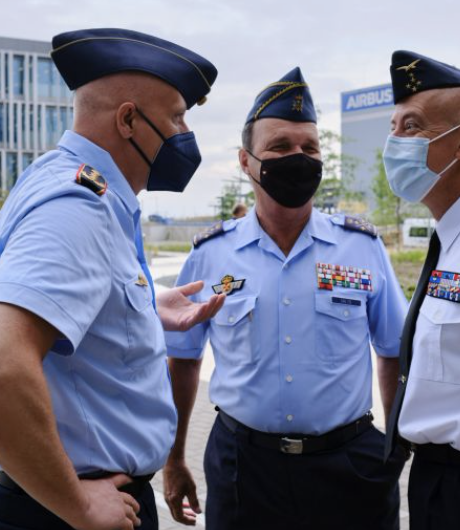By Pierre Tran
Paris – The French, German and Spanish air chiefs were briefed June 17 and 18 by three companies leading the industrial effort on a European Future Combat Air System, the three nations said in a joint statement.
The official visits were made just days before German parliamentarians were due June 23 to decide on authorization of a €3.5 billion budget for phase 1B development work on the three nation FCAS project.
French general Philippe Lavigne, German lieutenant-general Ingo Gerhartz, and German general Javier Salto Martinez-Avial received updates on concept studies while visiting Indra in Madrid, Spain, Airbus in Manching, Germany, and Dassault Aviation in Saint Cloud, France, the June 18 statement said. A combined project team at Arceuil, just outside the French capital, also briefed the officers.
The meetings reviewed operational aspects of a next generation fighter and remote carrier drones, dubbed Next Generation Weapon System, the statement said.
NGWS will be the core element in the future combat air system, which seeks to deliver a “combat cloud” network to hook up aircraft including Rafale, Eurofighter Typhoon, a European unmanned aerial vehicle, MRTT inflight refueling tanker, C295 and A330M transport aircraft.
That FCAS will also seek to be interoperable with the F-35 and F-22 fighters, and AWACS aircraft.
“The three air chiefs continue to meet on a regular basis in order to keep track of progress within the project NGWS and provide their command level operational perspectives,” the statement said.
The officers received “detailed project information” from military experts and company executives.
The NGWS concept draws on a “joint all-domain” warfare capability, the statement said, leading to a complexity that “exceeds everything that has ever been imagined and produced in a European cooperation project so far.”
Development of the technology demonstrator is seen as a milestone in maturing technology and cutting risk on NGWS, the statement said, which will be operationally superior and a system of systems offering interoperability.
“The air chiefs are already looking forward to see the project entering the next phase and subsequently to receive the results of the first real life demonstrations,” the statement said.
The demonstrators of the new fighter and remote carriers are due to fly in 2027.
That demonstrator is expected to be based on a Rafale rather than a Eurofighter Typhoon, reflecting the program management role of Dassault.
That air chiefs pointed up the value and importance of trilateral work in operational and technical areas, allowing national views and priorities to be factored into the project, the statement said.
A European capability was seen as important for autonomous sovereignty.
Development of European technology is “crucial to achieve independence and resilience to maintain security in Europe,” the statement said.
That three-nation project effectively competes with the Tempest program led by the UK, teamed up with Italy and Sweden, to deliver their new fighter and unmanned aircraft in 2035.
That is five years earlier than the entry into service of the Franco-German-Spanish fighter and remote carriers in 2040.
The French, German and Spanish companies had been reported to be in negotiation with the governments, which had been seeking a cost cut of five percent.
The talks also were reported to include industry calls for respect of intellectual property rights.
The need for German parliamentary approval had effectively set a hard deadline for reaching agreement on the budget and IPR.
While the French procurement office was confident of a green light by the German parliamentary finance committee, there was less optimism for approval of spending for a Main Ground Combat System – a Franco-German project for a new tank, upgrade on the Tiger Mk3 attack helicopter, and a Maritime Airborne Warfare System (MAWS), business website La Tribune reported.
The latter will to replace the Atlantique 2 and P-3C Orion maritime patrol aircraft flown respectively by French and German navies.
Funding for those three projects will likely have to wait until after German general election results are counted in September, returning a new government and a new parliament.


